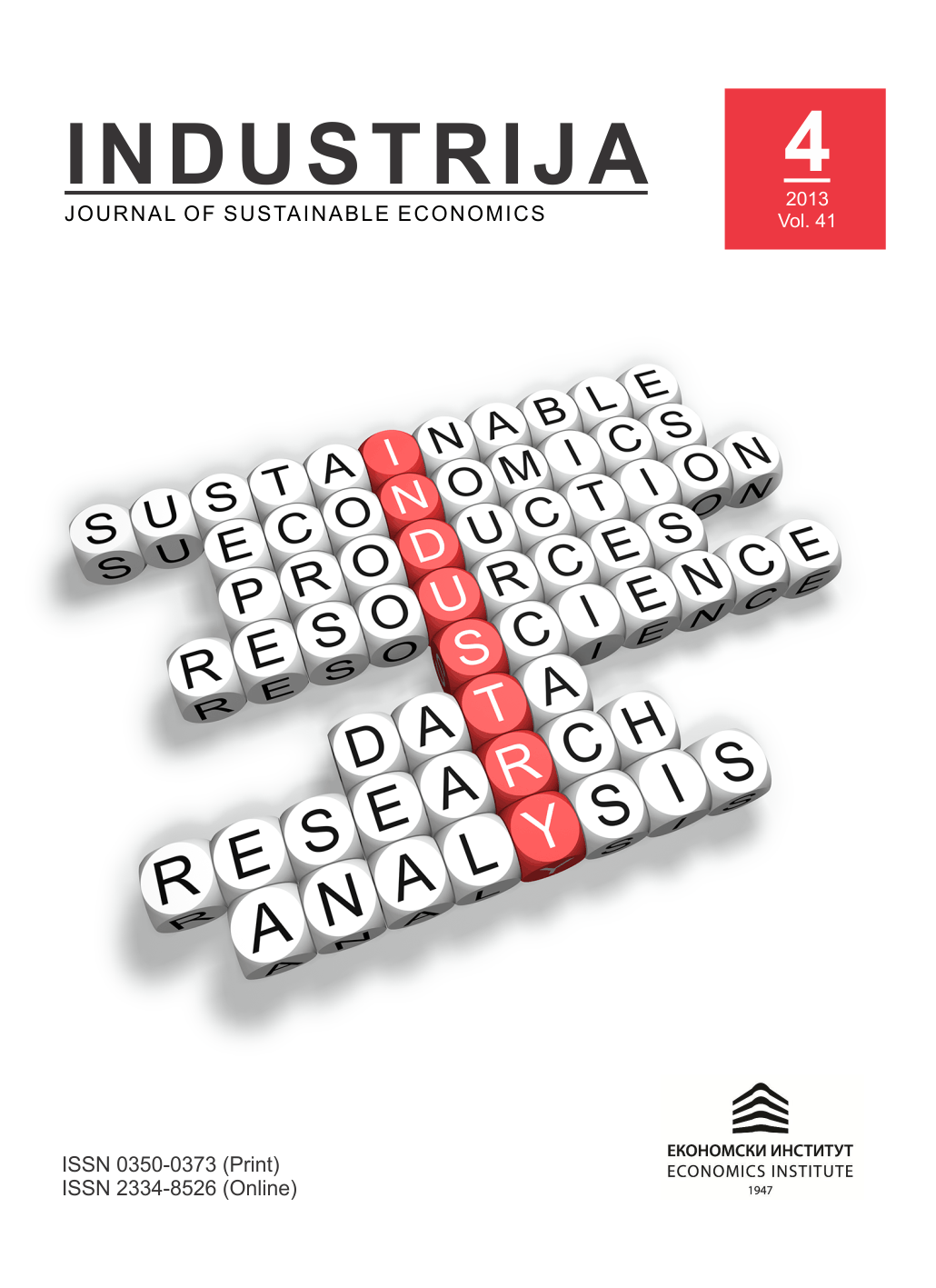Testing of real exchange rate - real interest rate differential relationship in Serbia-EMU case
Abstract
The goal of this study is to investigate whether there are empirical proofs for sustainability of real exchange rate - real interest rate differential relation in Serbia – EMU case for the period between January 2007 and May 2012. Theoretical relation has been derived by combining uncovered interest rate parity and Fisher equation, while empirical testing has been based on time series cointegration concept and application of Johansen and Engle-Granger cointegration test. The findings we obtained have shown that real exchange rate index and real interest rate differential are not cointegrated series, i.e. that there is no long-run equilibrium relation between them. Based on such findings we can conclude that there are no empirical proofs that real exchange rate - real interest rate differential relation is a key to explain dynamics of RSD/EUR real exchange rate.
References
Baxter, M. (1994). Real exchange rates and real interest differentials. Journal of Monetary Economics, 33, 5-37.
Byrne, P. J., & Nagayasu, J. (2010). Structural breaks in the real exchange rate and real interest rate relationship. Global Finance Journal,21,138–151.
Campbell, Y. J., & Clarida, H. R. (1987). The dollar and real interest rates. NBER Working Paper No. 2151. doi:10.1016/0167-2231(87)90005-4. Retrieved from http://dash.harvard.edu/bitstream/handle/1/3221495/campbell_dollarrealinterest.pdf?sequence=2
Chortareas, E. G., & Driver, L. R. (2001). PPP and the real exchange rate–real interest rate differential puzzle revisited: Evidence from non-stationary panel data. Bank of England Working Paper No. 138. Retrieved from http://www.bankofengland.co.uk/publications/Pages/workingpapers/2001/wp138.aspx
Clarida, R., & Gali, J. (1994). Sources of real exchange rate fluctuations: How important are nominal shocks? NBER Working Paper No. 4658. Retrieved from http://www.nber.org/papers/w4658.pdf?new_window=1
Dornbusch, R. (1976). Expectations and exchange rate dynamics. Journal of Political Economy, 84(6), 1161-1176.
Edison, J. H., & Melick, R. W. (1999). Alternative approaches to real exchange rates and real interest rates: Three up and three down. International Journal of Finance and Economics, (4), 93–111.
Edison, J. H., & Pauls, D. B. (1991). A re-assessment of the relationship between real exchange rates and real interest rates: 1974–1990. IFDP Working Paper No. 408. Retrieved from http://www.federalreserve.gov/pubs/ifdp/1991/408/ifdp408.pdf
Engel, C., & Kim, C-J. (1999). The long-run U.S./U.K. real exchange rate. Journal of Money, Credit and Banking, 31(3), 335-356.
Frenkel, A. J. (1976). A monetary approach to the exchange rate: Doctrinal aspects and empirical evidence. The Scandinavian Journal of Economics, 78(2), 200-224.
Kanas, A. (2005). Regime linkages in the US/UK real exchange rate–real interest differential relation. Journal of International Money and Finance, 24, 257–274. doi:10.1016/j.jimonfin.2004.12.006
MacDonald, R., & Nagayasu, J. (1999). The long-run relationship between real exchange rates and real interest rate differentials: A panel study. IMF Working Paper No. 37. Retrieved from http://www.imf.org/external/pubs/ft/wp/1999/wp9937.pdf
Meese, R., & Rogoff, K. (1988). Was it real? The exchange rate-interest differential relation over the modern floating-rate period. The Journal of Finance, 43(4), 933-948.
Nakagawa, H. (2002). Real exchange rates and real interest differentials: Implications of nonlinear adjustment in real exchange rates. Journal of Monetary Economics, 49, 629–649.
Petrović, P. (2013). Testing of empirical grounds for theoretical models of real exchange rate: Research of real exchange rate between RSD and Euro. Industrija, 41(1), 99-115. doi: 10.5937/industrija41-3522
Saikkonen, P., & Lütkepohl, H. (2000). Testing for the cointegrating rank of a VAR process with structural shifts. Journal of Business & Economic Statistics, 18(4), 451-464.

